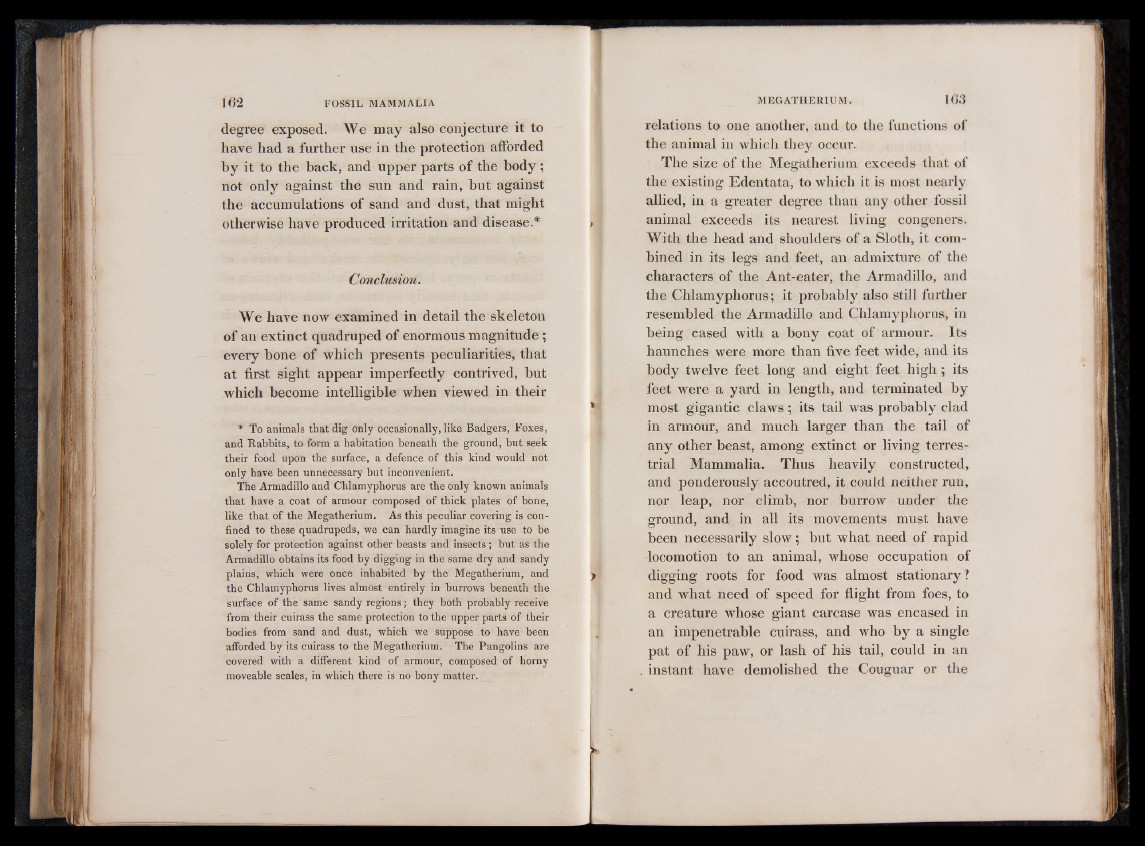
degree exposed. We may also conjecture it to
have had a further use in the protection afforded
by it to the backhand upper parts of the body ;
not only against the sun and rain, but against
the accumulations of sand and dust, that might
otherwise have produced irritation and disease.*
Conclusion.
We have now examined in detail the skeleton
of an extinct quadruped of enormous magnitude;
every bone of which presents peculiarities, that
at first sight appear imperfectly contrived, but
which become intelligible when viewed in their
* To animals that dig only occasionally, like Badgers, Foxes,
and Rabbits, to form a habitation beneath the ground, but seek
their food upon the surface, a defence of this kind would not
only have been unnecessary but inconvenient.
The Armadillo and Chlamyphorus are the only known animals
that have a coat of armour composed of thick plates of bone,
like that of the Megatherium. As this peculiar covering is confined
to these quadrupeds, we can hardly imagine its use to be
solely for protection against other beasts and insects ; but as the
Armadillo obtains its food by digging in the same dry and sandy
plains, which were once inhabited by the Megatherium, and
the Chlamyphorus lives almost entirely in burrows beneath the
surface of the same sandy regions; they both probably receive
from their cuirass the same protection to the upper parts of their
bodies from sand and dust, which we suppose to have been
afforded by its cuirass to the Megatherium. The Pangolins are
covered with a different kind of armour, composed of horny
moveable scales, in which there is no bony matter.
relations to one another, and to the functions of
the animal in which they occur.
The size of the Megatherium exceeds that of
the existing Edentata, to which it is most nearly
allied, in a greater degree than any other fossil
animal exceeds its nearest living congeners.
With the head and shoulders of a Sloth, it combined
in its legs and feet, an admixture of the
characters of the Ant-eater, the Armadillo, and
the Chlamyphorus; it probably also still further
resembled the Armadillo and Chlamyphorus, in
being cased with a bony coat of armour. Its
haunches were more than five feet wide, and its
body twelve feet long and eight feet high ; its
feet were a yard in length, and terminated by
most gigantic claws; its tail was probably clad
in armour, and much larger than the tail of
any other beast, among extinct or living terrestrial
Mammalia. Thus heavily constructed,
and ponderously accoutred, it could neither run,
nor leap, nor climb, nor burrow under the
ground, and in all its movements must have
been necessarily slow; but what need of rapid
locomotion to an animal, whose occupation of
digging roots for food was almost stationary?
and what need of speed for flight from foes, to
a creature whose giant carcase was encased in
an impenetrable cuirass, and who by a single
pat of his paw, or lash of his tail, could in an
instant have demolished the Couguar or the